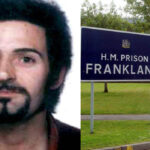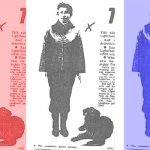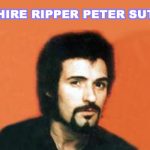The Ripper Strikes North
by TIM HICKS and CHRIS CLARK
~~~~~
Introduction
Following on from the new evidence gathered by the authors and NYE citizen journalist Nigel Ward, and revealed in the article “Hope”: New evidence.
The authors have had time to consider the impact that this new evidence has had on their knowledge of the full range of ‘Yorkshire Ripper’ Peter Sutcliffe’s pattern of offending. It is quite startling.
Background: Numbers of Victims and Force Areas
Peter Sutcliffe’s reign of terror finished on the 2nd of January 1981 when he was arrested in Sheffield by South Yorkshire Police armed and with a prostitute. This woman was no doubt intended to be another of his victims and his arrest certainly saved her life.
He was convicted of having committed thirteen murders and seven attempted murders. These are shown in Table 1. In addition to the offences he was convicted of, he admitted two offences and was not charged in another four, which are also shown in Table 1 below.
An antecedent investigation conducted by Chief Constable Sir Lawrence Byford – which has never been released to the public in full (only a redacted copy) – is believed to have identified another murder and eight attempted murders that Sir Lawrence was satisfied that Sutcliffe had committed.
A similar investigation by Assistant Chief Constable Keith Hellawell for West Yorkshire Police originally looked at 78 additional cases which he firstly reduced down to 60, and down to 45, and eventually, because of weight of numbers, down to a final 22. Twelve in West Yorkshire and ten elsewhere.
These are shown in Table 2 below.
A grand total of thirty five murders and attempted murders.
Readers can view Spreadsheet Ripper 1 (Table 1, Table 2 and Table 3) here. [Opens in a new Tab).
On the 17th of February 1979 there was an attempted murder in Harrogate. NYE investigation here. Sutcliffe was a suspect in this attack and it was put to him in prison. He vehemently denied being responsible. Obviously his denial cannot be used to eliminate him and it was one of the attacks assessed by Sir Lawrence Byford as having been committed by him. He therefore presumably remains a suspect for this brutal attempted murder, which is entirely consistent with his modus operandi. The authors remain satisfied that Sutcliffe was responsible for this attack.
Sutcliffe’s offending was nevertheless perceived to be limited to offences localised to the GMP, WYP and SYP force areas. The Harrogate attack being seen as an isolated incident. In all of these offences, he was believed to have used his own vehicle.
Other than the attempted murders of Ann Rooney and Tracey Brown – which he admitted – Sutcliffe has denied committing all of the many offences that were put to him after his conviction.
Enter Chris Clark
Neither of the authors were convinced by the accepted assessment of thirty-five attacks.
Chris however took it a stage further and using his experience as a police intelligence officer, conducted his own antecedent investigation into the full extent of Sutcliffe’s offending. This was published in his book “Yorkshire Ripper The Secret Murders”, NYE review here.
Chris’s investigation revealed a far wider pattern of offending. Chris then teamed up with Tim to use the NYE as a vehicle to continue and expand Chris’s investigation. Their partnership has proved eminently successful.
The NYE investigation into the murder of “Hope” or the “Nude in the Nettles” has revealed further evidence.
The authors’ assessment is that Peter Sutcliffe committed at least sixty murders and attempted murders over multiple force areas. These are shown in Table 7 below, which has been continually updated by the authors as more information has emerged.
Readers can view Spreadsheet Ripper 5 (Table 12, Victim List), here. [Opens in a new Tab).
The authors assert that this is the most comprehensive assessment of the full range of Sutcliffe’s crimes available anywhere.
The most concerning of these four tables is Table 3. Please note the difference in the numbers of attacks compared to 1977. Serial killers generally become more prolific as time progresses because they acquire a taste for killing, enjoy it more, become more confident and also more skilled at what they do. However the frequency of Sutcliffe’s known murders is not consistent with this pattern. It shows a peak in 1977, when you would expect it to show a steady rise in the number of attacks over the period of his offending, with the peak in 1980.
This leads the authors to conclude that it is still incomplete. They fear the true number of Sutcliffe’s victims is probably very much higher than the sixty the police and the authors have identified above.
The wider implications of the “Hope”/”Nude in the Nettles” case.
The extra information that emerged from the NYE “Nude in the Nettles” investigation, has now enabled the authors to expand their analysis of Sutcliffe’s offending, both in terms of his modus operandi and the geographical extent of it.
1). Sutcliffe’s “conceal and decoy” modus operandi
One of the major revelations to emerge from Chris’s work is that it became clear that Sutcliffe was forensically aware and routinely changed his modus operandi, to confuse the police investigation. He used different weapons (ball pein hammer, claw hammer, masonry/lump/walling hammer, knife, ligature, cross head screwdriver, bradawl made from a sharpened cross head screwdriver) to kill and mutilate his victims.
He also changed his car regularly and varied his geographical area of operation. As an example, the foray into South Yorkshire in 1981 was undoubtedly due to his caution in avoiding the red light districts in West Yorkshire, because he knew they were under close police surveillance.
One of the more puzzling cases was the murder of Yvonne Pearson. This appeared to be unique because Sutcliffe concealed the body beneath a sofa and it remained undiscovered for two months. NYE article with more information here.
The body was discovered because a passer-by noticed an arm poking out from the sofa. When the body was removed, the police found a newspaper underneath the body dated the 21st of February 1978. The police investigation identified that other witnesses who had passed the sofa confirmed that there had been no arm showing in the period between the murder on the 22nd of January 1978 and the discovery of the body.
They concluded – correctly in both author’s opinions – that Sutcliffe had returned to the body, placed the newspaper underneath the body, hoping the police would use the date on the newspaper to establish the wrong date for the murder. Thereby establishing a false alibi for himself. He then moved the arm so it was exposed, to ensure discovery of the body with the newspaper underneath it shortly afterwards.
“Hope’s” body was also concealed and a dated item (a yoghurt top) put underneath it. The authors believe this was to establish a false alibi. Exactly the same method used in the Yvonne Pearson attack.
2). Sutcliffe’s vehicle strategy
In all the offences accepted as having been committed by Sutcliffe in Tables 1 and 2, he used his own car.
The implication of the new evidence developed by the NYE is that Sutcliffe picked up his victim “Hope” from Scarborough in his lorry.
The authors assess that in the murder of “Hope” he concealed the body and returned to place the yoghurt top underneath it to again establish a false alibi, because the records of his employer would show the exact dates that he had been in Scarborough. If the body was discovered the day after the murder, this would tie him to it. By introducing delay and the confusion of the yoghurt top date, Sutcliffe would prevent that.
The authors therefore assert that Sutcliffe had another distinct modus operandi of using his employer’s lorry to commit murders and then concealing the bodies. This is a major development.
3). Geographical range of Sutcliffe’s offending
Sutcliffe trained as an HGV driver in the Harrogate area in February 1975, then worked as an HGV driver in Bradford from September 1975 to March 1976 then from September 1976 until his arrest in January 1981. Giving him access to a lorry.
During these two periods he was driving all over the UK unsupervised and in particular driving from his employer in Bradford to Sunderland Docks and to Scarborough.
Sutcliffe’s lorry had a large cab and could be used to sleep in. Here opinion is divided between the authors. Sutcliffe never contaminated his vehicle by killing in it and therefore Chris is convinced that Sutcliffe would not have murdered anyone in the cab of the lorry. Tim is not so convinced. Ligature strangulation leaves no blood and is quiet. Tim believes it is just possible that Sutcliffe may have murdered in the cab using ligature strangulation. This would certainly be a departure from Sutcliffe’s known modus operandi, but Sutcliffe varied his modus operandi. So Tim believes this cannot be ruled out.
This new evidence also means that Sutcliffe could have been committing murders while travelling in his lorry, staying in lorry parks and making deliveries to Scarborough, Sunderland Docks and many major towns and cities in the Cleveland, Durham, North Yorkshire and Northumbria force areas.
Chris and Tim have identified an attempted murder and two murders in these areas that they believe may have been committed by Peter Sutcliffe.
These are:
- The murder of Stephanie Slater at Darlington (Durham Constabulary) in May 1977. See below. Northern Echo article by Nigel Burton here.
- The attempted murder in Harrogate (North Yorkshire Police) on the 17th of February 1979.
- The “Nude in the Nettles” murder of “Hope” in Scarborough (North Yorkshire Police) in 1979. North Yorkshire Police have not yet followed up on the new evidence produced by the NYE and consequently he cannot have been eliminated from this enquiry.
4). The murder of Stephanie Spencer
Three of the cases the authors assert were committed by Peter Sutcliffe, were the subject of a miscarriage of justice, in which the wrong man was convicted and subsequently cleared. These are:
- The murder of Carol Wilkinson. Wikipedia article here.
- The murder of Wendy Sewell. Wikipedia article here.
- The murder of Judith Roberts. Wikipedia article here.
In the case of the murder of Stephanie Spencer, Michael Hodgson was convicted of her murder. However the authors are concerned that this may also have been a miscarriage of justice and that the murder was actually committed by Peter Sutcliffe.
Twenty-five-year-old Stephanie Spencer was beaten to death with a rock and her body found concealed in bushes in Darlington on the 29th of May 1977. An unemployed labourer Michael Hodgson was interviewed. He admitted having an argument with her and said “something snapped, she just provoked me”. This was taken as a confession. The prosecution asserted she had died on the Friday the 27th of May, but three witnesses said they had seen her alive the next day. Forensic tests identified that she had had sex with a man who was not Hodgson.
Hodgson was convicted of her murder. He continues to maintain his innocence.
The authors believe Sutcliffe should be considered as a suspect because:
- The murder is consistent with Sutcliffe’s modus operandi.
- As a result of the NYE investigation it has now emerged that Peter Sutcliffe was operating over a much larger geographical area and was probably offending along the A19.
- Sutcliffe was seen at the Flamingo’s nightclub on the weekend of the murder.
- A man fitting Sutcliffe’s description was seen arguing with Stephanie Spencer at Flamingo’s nightclub.
- Serial killers operate in areas they are familiar with and comfortable operating in. The deposition site was a lorry park that would have been known to Sutcliffe. Sutcliffe’s work took him to Sunderland, Darlington and Newton Aycliffe regularly. He visited Darlington and nearby Newton Aycliffe at least 14 times during his reign of terror.
- The body was concealed, which is consistent with Sutcliffe’s modus operandi and exactly the same as the “Nude in the Nettles” murder.
Sutcliffe enjoyed driving and travelled widely. Darlington is about one and a half hours drive from Bradford. The 1981 attack in Sheffield shows that Sutcliffe varied his area of operation to evade police surveillance by operating in force areas he was not believed to offend in. The police were never able to ascertain how long he had used this tactic for.
The authors assert that this is why he chose Darlington to commit a murder.
They believe he went there socially in his car to attend the disco and conducted an opportunist attack on Stephanie Spencer, then dumped her body in the lorry park. Probably in a place he had previously selected for this purpose, identified during one of his visits to Darlington in his lorry.
The failure of the 1981 antecedent investigations
The authors have concluded that as a result of the NYE investigation into the “Nude in the Nettles” investigation, it is probable that Sutcliffe was using his lorry to offend in the North Yorkshire, Cleveland, Durham and Northumbria Police Force Areas and, uniquely, concealing the bodies to evade detection. This means that there could be missing persons cases in these force areas that Sutcliffe was responsible for, which are classified as missing persons, but are in fact murders.
This would account for the fluctuations in the numbers of attacks in the later years of his offending revealed by Table 3.
When Sutcliffe was arrested in 1981, all forces conducted a review of their unsolved murders to ascertain if they had been committed by Sutcliffe. The attempted murder in Harrogate for instance was one of those that was put to Sutcliffe as a result of this review.
However, the Yvonne Pearson murder is seen as an isolated one-off from his normal modus operandi. At the time it was not realised that Sutcliffe also concealed bodies. This has only been revealed as a result of Chris linking Sutcliffe to the “Nude in the Nettles” murder and the fresh evidence this has generated.
Consequently, Sutcliffe was not believed to be responsible for murders of women that had disappeared and were classified as missing persons. So missing persons were not included in the Yorkshire Ripper antecedent investigation.
NYE widens the scope of its investigation
Prior to the NYE coverage and the new evidence it generated, the “Nude in the Nettles” murder had never previously been linked to Sutcliffe. Sutcliffe’s offending was believed to be limited to the West Yorkshire, South Yorkshire and Greater Manchester Police areas and the one attack in Harrogate.
If Sutcliffe did change his modus operandi to include concealing the body, it could mean that there are some women that are officially designated as missing, but were in fact murdered by Sutcliffe, whose bodies are still undiscovered.
This should result in a cold case review of all unsolved murders and attempted murders of women between September 1975 to March 1976 then from September 1976 to December 1980 in the Cleveland, Durham, North Yorkshire and Northumbrian force areas, and all cases of missing women in the same period, to see if they can be attributed to Peter Sutcliffe.
Tim is in the process of writing to the Chief Constables of these forces to bring their attention to this and requesting that a cold case review is conducted to see if any of these cases should be put to Sutcliffe:
Obviously, at a time of austerity, this message will not go down well with the various Chief Constables involved. They will understandably not want to expend scarce resources investigating historical cases, when the probable offender is in prison for a full life term. Nor will they want to admit to past failings by their force, particularly on a high profile case like the Yorkshire Ripper.
Hence Chris and Tim believe that this type of historical cold case investigations should be performed by a specialist centrally organised squad, which can investigate impartially, without being affected by police cap-badge politics.
Coming Next
- “The Ripper Strikes South: The Lorry Murders”
NYE Appeal for information
“Hope”:

Three-dimensional wax reconstruction of the victim’s head and face
- She was 5’ 2” in height, aged between thirty-five and forty.
- She had a slender build and wore her natural dark brown hair in a page-boy style.
- She had given birth to two or three children and had a displaced septum between her nostrils.
- Her toenails were painted pink – the varnish coming from the Max Factor Maxi range.
- She would have worn a size four shoe.
- Staining on her teeth revealed that she was a heavy smoker that did not look after herself.
- She had a Yorkshire or Lancashire accent, but may not be originally from Scarborough.
- All her upper teeth were missing, she had an upper dental plate fitted, and she had only six lower teeth.
- She had an old fracture to her right ankle and an abnormality to her neck vertebrae which would have caused backache.
- Do you remember someone like this from the shelter in Victoria Road, Scarborough?
- Were you one of “Hope’s” clients?
- Were you a police officer in Scarborough in the period 1977 – 1979? Did “Hope” come into custody for being drunk and disorderly, soliciting or vagrancy, or did you see her at the shelter?
- Were you a social worker, health care professional, or member of the Salvation Army that came into contact with “Hope” and other down and outs from Victoria Road Scarborough?
- Did you find a dark blue quilted body warmer, blouse, jumper, dark mini skirt discarded along on the A170?
Peter Sutcliffe:
Peter Sutcliffe pictured in his TW Clark lorry, circa 1976
- Did you see Peter Sutcliffe (image below) or a lorry from TW CLARK (image above) in Scarborough or any of the locations mentioned in the article?
- Did you work at Victoria Road, Roscoe Street, Andrews of Scarborough (motorcycle dealers), Deardens builders merchants, North Sea Winches D, Wray and Sons, Scarborough Ignition Co Ltd or Pickups or the old goods yard which is now Sainsburys?
- Were you a taxi driver for Boro Taxis next to the café, or did you use taxis from there?
- Did you frequent the café in Victoria Road and see Peter Sutcliffe there?
- Did you know the café owner, Iris Scott?
If you have any information on the “Nude in the Nettles” mystery that you want to pass on confidentially, you can talk to a journalist by contacting the North Yorks Enquirer using our letters@NYEnquirer.uk address. All responses will be treated in the strictest confidence.














